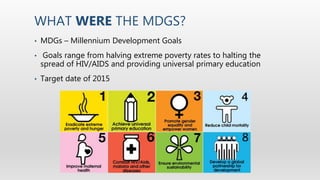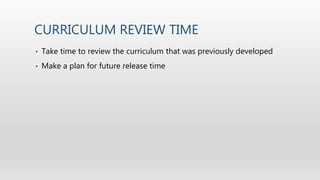Global challenges
- 2. INTRODUCTIONS • Name • Building • Subject • Grade Level • Previous Role (if any) in Global Challenges 1.0
- 3. WELCOME ACTIVITY Directions: • You will 30 seconds to answer the question on your paper • When time is up, slide the paper to the person on your right • Repeat
- 4. GENERAL UPDATES • K-12 – March 26th • Will need to go to councils and departments before March 26th • Bond Update • Release Days • Whole Group - January 30th • Small group days? • Implementation prep days planned for 4/10, 5/9, 6/5
- 5. WHAT WERE THE MDGS? • MDGs – Millennium Development Goals • Goals range from halving extreme poverty rates to halting the spread of HIV/AIDS and providing universal primary education • Target date of 2015
- 7. MDGS KEY FACTS (JUDGED BY 1990 LEVELS)MDG 1: The number of people living on less than $1.25 a day has been reduced from 1.9 billion in 1990 to 836 million in 2015, although the target of halving the proportion of people suffering from hunger was narrowly missed. MDG 2: Primary school enrolment figures have shown an impressive rise, but the goal of achieving universal primary education has just been missed, with the net enrolment rate increasing from 83% in 2000 to 91% this year. MDG 3: About two-thirds of developing countries have achieved gender parity in primary education. MDG 4: The child mortality rate has reduced by more than half over the past 25 years – falling from 90 to 43 deaths per 1,000 live births – but it has failed to meet the MDG target of a drop of two-thirds. MDG 5: The global maternal mortality ratio has fallen by nearly half – short of the two-thirds reduction the MDGs aimed for. MDG 6: The target of halting and beginning to reverse the spread of HIV/Aids by 2015 has not been met, although the number of new HIV infections fell by around 40% between 2000 and 2013. MDG 7: Some 2.6 billion people have gained access to improved drinking water since 1990, so the target of halving the proportion of people without access to improved sources of water was achieved in 2010 – five
- 8. THE MILLENNIUM DEVELOPMENT GOALS WERE REPLACED BY THE SUSTAINABLE DEVELOPMENT GOALS IN 2015
- 9. WHAT ARE THE SDGS • Also known as the Global Goals • Collection of 17 Global Goals set by the United Nations General Assembly in 2015 • Contain 169 targets with 17 goals • Cover social and economic development issues including poverty, hunger, health, education, global warming, general equality, water, sanitation, energy, urbanization, environment, and social justice. • Unlike the MDGs, they focus more on the causes of the problems than the problems themselves
- 10. WHAT ARE THE SDGS?
- 11. SDGS • There are far more educational resources available for the SDGs • Go to the following website and explore: • https://www.un.org/sustainabledevelo pment/ Explore and take a break! We will come back together in 15 minutes.
- 12. ORIGINAL PLAN • 6th Grade • World Resources (Replaces Poetry) – Implement Fall 2017 • 7th Grade • Global Democracy (Replaces Autobiography/Biography) – Implement Fall 2018 • Economics & Education (Replaces Myths & Legends) – Implement Fall 2018 • 8th Grade • Global Convergence & Information Technology (Replaces Science Fiction) – Implement Fall 2018 • Emerging Technologies Effect on Climate & Energy (Replaces Realistic Fiction) – Implement Fall 2018 • Capstone
- 13. NEW PLAN • 6th Grade • World Resources (Replaces Poetry) – Implement Fall 2019? • 7th Grade • Global Democracy (Replaces Autobiography/Biography) – Implement Fall 2020? • Economics & Education (Replaces Myths & Legends) – Implement 2020? • 8th Grade • Global Convergence & Information Technology (Replaces Science Fiction) – Implement Fall 2020? (with possible pilot in in 2019) • Emerging Technologies Effect on Climate & Energy (Replaces Realistic Fiction) – Implement Fall 2020? • Capstone Not part of the new plan
- 14. NEW PLAN • Update the Global Challenges Courses using the Sustainable Development Goals • Incorporate some of the ELA standards for reading, writing, speaking, and listening into the design of the courses • Use what was previously developed (or as much of it as possible) in the updated version • Review the concerns in the previous proposal and try to find possible solutions
- 15. ACTIVITY – HOW WOULD YOU DIVIDE UP THE SDGS FOR GLOBAL CHALLENGES • In pairs, divide the 17 SDGs into 5 Global Challenges Courses. • 6th Grade Global Challenges • 7th Grade Global Challenges – A • 7th Grade Global Challenges – B • 8th Grade Global Challenges – A • 8th Grade Global Challenges – B • Question – Do we include #17?
- 16. HOW DOES THIS FIT INTO THE ORIGINAL PLAN? • 6th Grade – World Resources (Clean Water, Population and Resources, Health Issues)** • 7th Grade A – Global Democracy (Democratization, Global Foresight & Decision Making, Peace and Conflict)** • 7th Grade B – Economics & Education (Rich-Poor Gap, Education, Status of Women)** • 8th Grade A – Global Convergence & Information Technology (Global Convergence of IT, Transnational Organized Crime, Global Ethics) • 8th Grade B – Emerging Technologies Effect on Climate & Energy (Sustainable Development and Climate Change, Energy, Science & Technology) **These courses are fully developed in Rubicon Atlas
- 17. HOW DOES THIS FIT INTO THE ORIGINAL PLAN? • 6th Grade – World Resources (Good Health and Well-being (3), Clean Water and Sanitation (6), Responsible Consumption and Production (12) • 7th Grade A – Global Democracy (Democratization, Global Foresight & Decision Making, Peace and Conflict)** 7, 8, 9, 11 • 7th Grade B – Economics & Education (Rich-Poor Gap, Education, Status of Women)** 1, 2, 4, 5,10 • 8th Grade A – Global Convergence & Information Technology (Global Convergence of IT, Transnational Organized Crime, Global Ethics) 16 • 8th Grade B – Emerging Technologies Effect on Climate & Energy (Sustainable Development and Climate Change, Energy, Science & Technology) 13, 14, 15 **These courses are fully developed in Rubicon Atlas
- 18. NEW - GLOBAL GOALS • 6th Grade – The Changing Environment – Climate Action (13), Life Below Water (14), Life on Land (15). • 7th Grade A – Overcoming Social Struggles – No Poverty (1), Zero Hunger (2), Good Health & Well-Being (3), Reduced Inequalities (10). • 7th Grade B – Equality for All – Quality Education (4), Gender Equality (5). • 8th Grade A – Peace & Justice – Peace Justice and Strong Institutions (16). • 8th Grade B – Building 21st Century Cities – Clean Water & Sanitation (6), Industry, Affordable and Clean Energy (7), Decent Work and Economic Growth (8), Innovation, and Infrastructure (9), Sustainable Cities and Communities (11), Responsible Consumption and Production (12).
- 19. WHICH COURSE WOULD YOU LIKE TO WORK ON? • We will have time today and in our upcoming release day to review and develop these courses. • Which course would you like to work on? • What are your areas of strength?
- 20. LUNCH See you in an hour!
- 21. ORIGINAL PROPOSAL • K-12 Curriculum Proposal • Costs included
- 22. GLOBAL CHALLENGES 1.0 FEEDBACK Pros Cons
- 23. GROUP DISCUSSION • How much of the con list was misinformation or lack of information? • What are some possible solutions to the cons?
- 24. CURRICULUM REVIEW TIME • Take time to review the curriculum that was previously developed • Make a plan for future release time
Editor's Notes
- Use Post it notes to group together with paperclips
























